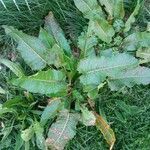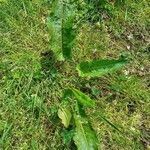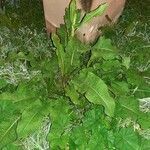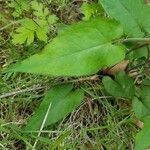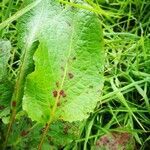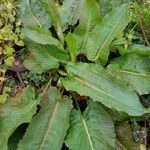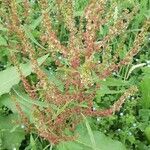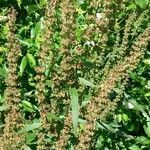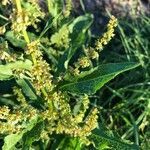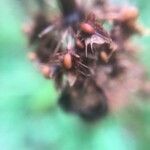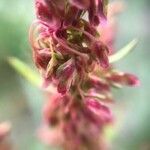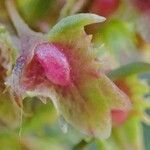Stout, tap-rooted ☿ or monoecious perennial; stems usually 30-100 cm tall, erect. Petiole of lower lvs usually much < lamina and with long, white, membranous ochreae. Lamina of lower lvs to 35-(50) × 15-(20) cm, ± oblong or oblong-ovate, ± membranous, often puberulent below, especially on veins; margins ± undulate; base cordate to rounded; apex obtuse or subacute. Cauline lvs becoming progressively smaller, narrower, and more tapered at base and apex. Infl. usually with several spreading branches; Whorls 10-many-flowered, usually contiguous, sometimes some rather remote; pedicels ± recurved, slender, glabrous, the lower subtended by a small lf; fls dense, strongly protandrous. Perianth 1.5-3 mm long, generally green at first, often becoming red where exposed to strong light; segments with hyaline margins; outer segments ± oblong or elliptic-oblong, not reflexed at fruiting; inner segments erect, greatly enlarged at fruiting. Fruiting valves 3.5-5 mm long, ± triangular with truncate base; margins with some teeth 1-1.7 mm long, but usually several shorter; apex rounded to obtuse; tubercle prominent, rosy, ± oblong, 2-2.5 mm long. Nut c. 2.5 mm long, glossy brown, sharply angled.
Herbs perennial. Roots vertical, large, to 1.5 cm in diam. Stems erect, 60-120(-150) cm tall, grooved, branched above middle or in upper 2/3, glabrous. Basal leaves: petiole 6-12 cm, minutely papillate; leaf blade broadly ovate to oblong-ovate or narrowly ovate, 15-30 × 6-15 cm, base cordate, abaxially sparsely minutely papillate, adaxially glabrous; cauline leaves shortly petiolate, narrowly ovate, small; ocrea fugacious, membranous. Inflorescence broadly paniculate, large; branches ascending. Flowers bisexual, dense. Pedicel filiform, slender, articulate below middle (in proximal third, rarely near middle). Inner tepals enlarged in fruit; valves narrowly triangular-ovate, 4-6 × 2-3 mm, usually 1 valve with tubercles, sometimes 3 valves with tubercles, but then 1 tubercle distinctly larger than other 2, base truncate, each margin with 2 or 5 teeth, apex obtuse to subacute; teeth 0.8-1.5 mm, apex straight. Achenes dark brown, shiny, ovoid, sharply trigonous, ca. 2.5 mm. Fl. May-Jun, fr. Jun-Jul. 2n = 40.
Stout perennial to 12 dm from a large tap or branched root, usually single-stemmed and simple to the infl; lower lvs cordate at base, broadly oblong to ovate, to 15 cm wide, the upper much smaller; infl freely branched, the lower verticils commonly separate and leafy-bracted; pedicels conspicuously longer than the fr, jointed below the middle; valves triangular-ovate, 3.5–5 mm, with 2–4 spinose teeth on each margin, one bearing a large, minutely wrinkled grain, the others merely with a slightly thickened midrib; 2n=50. Native of Europe, commonly naturalized in waste ground, especially in moist soil, from Que. and N.S. to B.C., s. to Fla. and Ariz.
A plant that keeps growing from year to year. It grows 1 m high and spreads 1 m wide. It has a long taproot. The stem is erect with spreading branches. The leaves are broad and blunt. The leaves are wavy. The flower spikes are crowded. The flowers are small and green. The seed valves have 1-4 teeth on each side.
